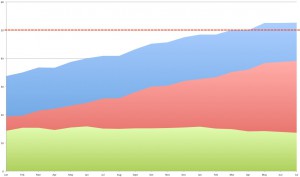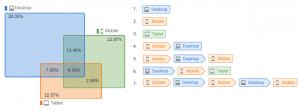We have been talking about mobile in real estate for far too long now. Two years ago Trulia, Zillow, and Realtor.com all announced that mobile was passing other methods of accessing their site. As brokers began to adopt mobile solutions, the debate about mobile browser vs. mobile app went on for an eternity until everyone put down their guns and agreed that the answer is both.
One of the broker website service providers that we have been tracking is Booj or The Enterprise Network. They offer a good benchmark because of their unique client base. If you are not familiar, here is the scoop.
The Enterprise Network only works with one broker in any given market. As a researcher, this eliminates the network effect that can often happen when a mobile solution is adopted by many firms in a given area.
No franchise means that the brokerage is standing on their own brand to drive awareness and adoption of mobile. Many franchise organizations drive mobile adoption in local markets, ie. Century 21 Hometown Realty gets all of the mobile traffic in their area for Century 21.
The Enterprise Network is geographically diverse. They cover the major market centers across America, mitigating geographic bias. I think that they have 32 brokerages across the nation representing 15,000 agents. Again, the average size of the brokerage is somewhat in the middle or “lower upper” in terms of agent count. Huge firms like Wiechert, Howard Hanna, Long and Foster, and the like can distort research.
Desktop browsers are dying in Real Estate Search
Having said all of that, it is significant to note that in March of 2015, mobile visitors to their mobile browser exceeded 50% of the total traffic to their customer websites. Desktop browsers are becoming the nursing homes of real estate search. It’s for old people who are not mobile enthusiasts.
Think Mobile First
The founders of the Broker Public Portal are hell bent on developing the website to be mobile first. This is a model that we expect to prevail in real estate. Last year, most brokerages looked at products on desktop browsers first, then took a look at the mobile solutions to “see if they were o.k.” That is all changing now. It’s a new day whereby if you do not focus on mobile first, you are likely to be investing in technology that is not long for the world.
The graph below shows what has happened in the last 18 months across the Booj network of broker sites. Unfortunately I do not have a better image to show you, but you can get the point. The red dotted line is the 50% mark. 18 months ago, only 35% of these companies’ web visitors were on mobile. 15% growth in 18 months is really big.
 Another note on reading the graph is that the green section is tablet users. The red section is phones. The blue section is the combination of the two. It is interesting to see that mobile phones are growing at such accelerated rate ahead of tablets.
Another note on reading the graph is that the green section is tablet users. The red section is phones. The blue section is the combination of the two. It is interesting to see that mobile phones are growing at such accelerated rate ahead of tablets.
Ido Zucker, CEO of Booj indicates that the graph accelerated much faster for brokerages that launched mobile apps first. Because the network did not adopt mobile apps at the same time, I hesitate to make a huge leap about that. Suffice it to say that a broker’s mobile strategy must be mobile browser friendly and include a mobile app. If you have one or the other, you may want to get out your technology wallet and complete your offering.
 At Booj they let data guide the way. They have set up methods to record and analyze user behavior across multiple devices. They use this data to create a better user experience for varying workflows to their members’ sites. Here are examples of the type of data generated.
At Booj they let data guide the way. They have set up methods to record and analyze user behavior across multiple devices. They use this data to create a better user experience for varying workflows to their members’ sites. Here are examples of the type of data generated.
Ido and I had a long conversation about where mobile traffic is coming from. I think that we agree that the majority of it is convenience based. For example, when opening alert emails and clicking to view new/updated listings. Broker sites notify consumers when a new listing matches their search criteria both as an email (driving mobile web), or an app alert that appears as a notification. People are more likely to take action on the device that is always in their hand rather than jump on a desktop. It’s just easier.
The data also shows that users often use a variety of devices over time. Convenience is the starting point, based on the device at hand, but then intent takes over when they can choose which device suits their needs best for that goal.
Key Points
- Your website should be responsive and work on all screens including mobile browsers. If you do not have the time or resources, there are a couple of companies that deliver purely mobile web solutions. Call me for some of my favorites.
- If you don’t have a mobile app – light one up right away – RE Technology has a pile of them to look at for your research.
- If you are planning a website purchase – start the conversation with the sales person by looking at mobile. If you are not in love with the experience, send them on their way.
WAV Group provides brokerages with vendor selection services. Be mindful that a chief consideration of a brokerage solution goes well beyond mobile and consumer websites. It includes co-branded agents websites and our sweet spot – the broker back office solution that integrates all business tools into one place for agents. If you need help or would just like a systems evaluation to highlight strengths and weaknesses, contact Victor Lund.




